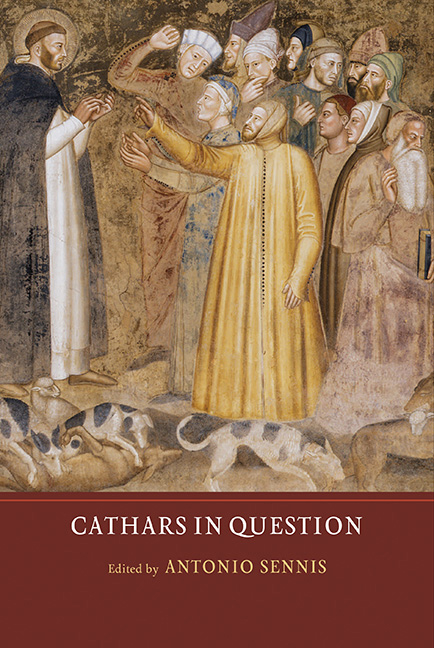Book contents
- Frontmatter
- Contents
- Acknowledgments
- 1 Questions about the Cathars
- 2 The Paradigm of Catharism; or, the Historians’ Illusion
- 3 The Cathar Middle Ages as a Methodological and Historiographical Problem
- 4 The Heretical Dissidence of the ‘Good Men’ in the Albigeois (1276–1329): Localism and Resistance to Roman Clericalism
- 5 The Heretici of Languedoc: Local Holy Men and Women or Organized Religious Group? New Evidence from Inquisitorial, Notarial and Historiographical Sources
- 6 Cathar Links with the Balkans and Byzantium
- 7 Pseudepigraphic and Parabiblical Narratives in Medieval Eastern Christian Dualism, and their Implications for the Study of Catharism
- 8 The Cathars from Non-Catholic Sources
- 9 Converted-Turned-Inquisitors and the Image of the Adversary: Ranier Sacconi Explains Cathars
- 10 The Textbook Heretic: Moneta of Cremona's Cathars
- 11 ‘Lupi rapaces in ovium vestimentis’: Heretics and Heresy in Papal Correspondence
- 12 Looking for the ‘Good Men’ in the Languedoc: An Alternative to ‘Cathars’?
- 13 Principles at Stake: The Debate of April 2013 in Retrospect
- 14 Goodbye to Catharism?
- Index
- Miscellaneous Endmatter
1 - Questions about the Cathars
Published online by Cambridge University Press: 31 March 2017
- Frontmatter
- Contents
- Acknowledgments
- 1 Questions about the Cathars
- 2 The Paradigm of Catharism; or, the Historians’ Illusion
- 3 The Cathar Middle Ages as a Methodological and Historiographical Problem
- 4 The Heretical Dissidence of the ‘Good Men’ in the Albigeois (1276–1329): Localism and Resistance to Roman Clericalism
- 5 The Heretici of Languedoc: Local Holy Men and Women or Organized Religious Group? New Evidence from Inquisitorial, Notarial and Historiographical Sources
- 6 Cathar Links with the Balkans and Byzantium
- 7 Pseudepigraphic and Parabiblical Narratives in Medieval Eastern Christian Dualism, and their Implications for the Study of Catharism
- 8 The Cathars from Non-Catholic Sources
- 9 Converted-Turned-Inquisitors and the Image of the Adversary: Ranier Sacconi Explains Cathars
- 10 The Textbook Heretic: Moneta of Cremona's Cathars
- 11 ‘Lupi rapaces in ovium vestimentis’: Heretics and Heresy in Papal Correspondence
- 12 Looking for the ‘Good Men’ in the Languedoc: An Alternative to ‘Cathars’?
- 13 Principles at Stake: The Debate of April 2013 in Retrospect
- 14 Goodbye to Catharism?
- Index
- Miscellaneous Endmatter
Summary
At the heart of this volume is the aspiration to tackle in a comparative perspective an issue which is highly controversial and hotly debated among scholars: the existence of a medieval phenomenon which we can legitimately call ‘Catharism’. Traditionally regarded as the most radical challenge to orthodox Catholicism in the medieval West, Catharism proposed that marriage is evil, just as the God of the Old Testament was evil and indeed different from the one of the New Testament, and that Christ never died in the flesh.
One of the main issues at stake is the question of whether what the inquisitors called ‘the heresy’ was an entity with a continuous existence over the years and with international dimensions spreading from the Balkans to Italy, and to southern France. Historians are more or less in agreement that the phenomena those repressing authorities described were largely localized, both geographically and chronologically. Was heresy, therefore, just a multiplicity of local, unconnected unorthodoxies? Or, on the contrary, can we indeed find a historically grounded connection between Catharism and a Balkan heresy such as Bogomilism, so that it is actually possible to talk of dualist dissent as a distinct movement in the central Middle Ages?
Words like ‘Catharism’ and ‘Bogomilism’ have obviously to be correctly understood, and the problem of what these sects and their members were actually called in thirteenth-century sources is central to all the papers in this volume. The authors also share a specific interest in understanding the extent to which the integrated world of twelfth- and thirteenth-century Europe was reflected in the existence of a connected network of heretical groups, or if, as recent historiographical trends have suggested, we are instead confronted with examples of local dissidence which responded to local needs and were shaped by local aspirations and cultural models. Finally, the organization of the Cathars, their Churches, has been the target of a strong critique in the past decades. Many of the papers here offer their view on the existence, or lack, of a structured hierarchy of religious management and control.
- Type
- Chapter
- Information
- Cathars in Question , pp. 1 - 20Publisher: Boydell & BrewerPrint publication year: 2016



